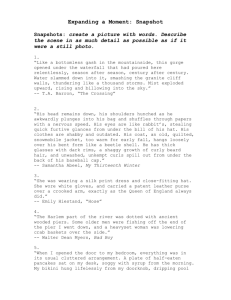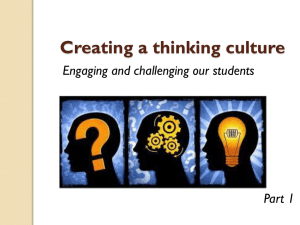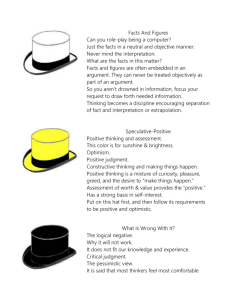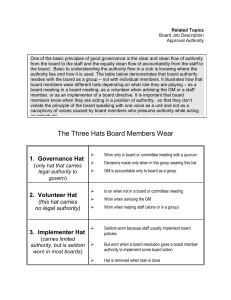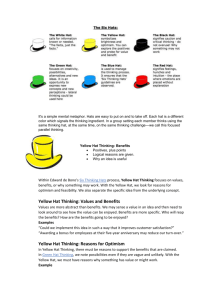Creative Methods - fast track mba @ sam
advertisement
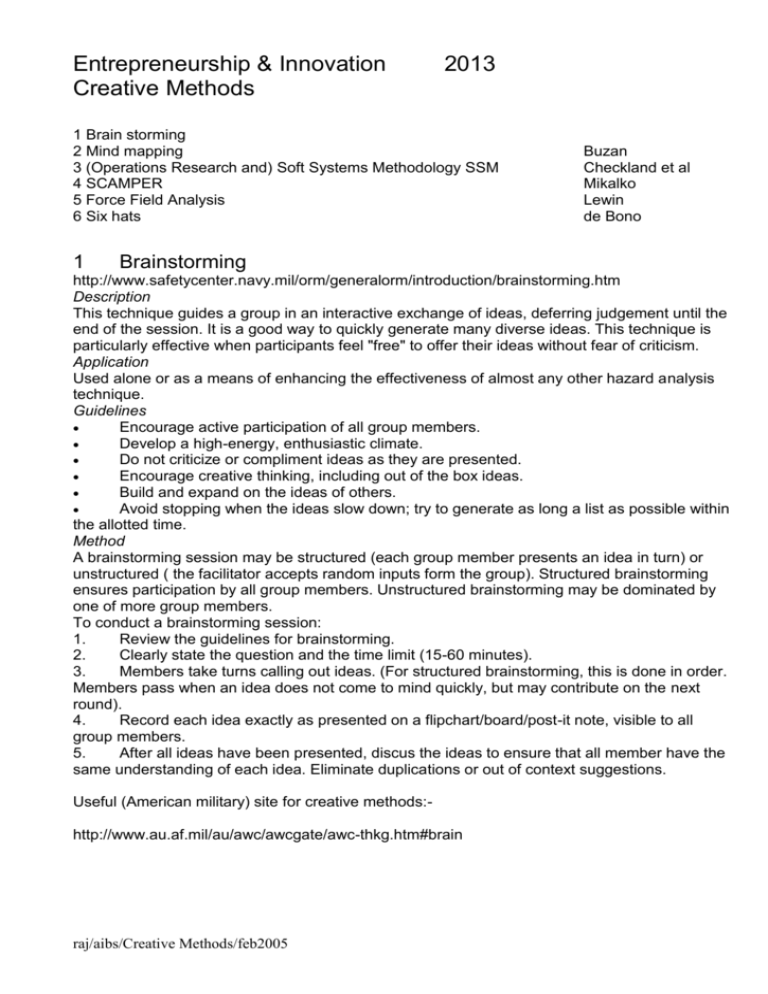
Entrepreneurship & Innovation Creative Methods 2013 1 Brain storming 2 Mind mapping 3 (Operations Research and) Soft Systems Methodology SSM 4 SCAMPER 5 Force Field Analysis 6 Six hats 1 Buzan Checkland et al Mikalko Lewin de Bono Brainstorming http://www.safetycenter.navy.mil/orm/generalorm/introduction/brainstorming.htm Description This technique guides a group in an interactive exchange of ideas, deferring judgement until the end of the session. It is a good way to quickly generate many diverse ideas. This technique is particularly effective when participants feel "free" to offer their ideas without fear of criticism. Application Used alone or as a means of enhancing the effectiveness of almost any other hazard analysis technique. Guidelines Encourage active participation of all group members. Develop a high-energy, enthusiastic climate. Do not criticize or compliment ideas as they are presented. Encourage creative thinking, including out of the box ideas. Build and expand on the ideas of others. Avoid stopping when the ideas slow down; try to generate as long a list as possible within the allotted time. Method A brainstorming session may be structured (each group member presents an idea in turn) or unstructured ( the facilitator accepts random inputs form the group). Structured brainstorming ensures participation by all group members. Unstructured brainstorming may be dominated by one of more group members. To conduct a brainstorming session: 1. Review the guidelines for brainstorming. 2. Clearly state the question and the time limit (15-60 minutes). 3. Members take turns calling out ideas. (For structured brainstorming, this is done in order. Members pass when an idea does not come to mind quickly, but may contribute on the next round). 4. Record each idea exactly as presented on a flipchart/board/post-it note, visible to all group members. 5. After all ideas have been presented, discus the ideas to ensure that all member have the same understanding of each idea. Eliminate duplications or out of context suggestions. Useful (American military) site for creative methods:http://www.au.af.mil/au/awc/awcgate/awc-thkg.htm#brain raj/aibs/Creative Methods/feb2005 Example of an industrial brainstorming application in the HAZOP (Hazard & Operability analysis) technique:- http://www.uscg.mil/hq/g-m/risk/e-guidelines/RBDM/html/vol3/08/v3-08-03.htm#32 raj/aibs/Creative Methods/feb2005 2 Mind mapping See Tony Buzan’s website for example mindmaps:- Mind Maps® act as the ‘Swiss Army Knife of the brain’ allowing you to improve and accelerate your learning and thinking skills. Our brains are divided into the left and right cortex. The left side is dedicated to tasks involving order, logic, words, lists, numbers and analysis, the right side deals with rhythm, colour, imagination and daydreaming. If we want to improve memory, learning and thinking skills we have to use the whole brain. A Mind Map® is a powerful graphic technique which provides a universal key to unlock the potential of the brain. It harnesses the full range of cortical skills - word, image, number, logic, rhythm, colour and spatial awareness - in a single, uniquely powerful manner. In so doing, it gives you the freedom to roam the infinite expanses of your brain. The Mind Map® can be applied to every aspect of life where improved learning and clearer thinking will enhance human performance. Originated in 1970 by Tony Buzan, Mind Maps® are now used by millions of people around the world - from the very young to the very old - whenever they wish to use there brains more effectively. Similar to a road map, a Mind Map® will: Give you an overview of a large subject/area Enable you to plan routes/make choices and let you know where you are going and where you have been Gather and hold large amounts of data Encourage problem solving by seeing new creative pathways Enable you to be extremely efficient Be enjoyable to look at, read, muse over and remember Attract and hold the eye/brain raj/aibs/Creative Methods/feb2005 3 Operations Research OR Based on modelling of organisational situations and processes. Operational Research (OR) originated from Systems Engineering, Problem solving Problem definition Objectives Alternatives System analysis of alternatives System selection System development Realisation Very logical but too narrow, we must include a wider view, by including “soft” issues:- OR OR Hard Systems analysis quantitative simulation Math theory Cybernetics Systems theory = aids to decision making “optimisation modelling Soft Systems Analysis recognises COMPLEXITY SSM defines the problem situation Our individual constructs are based on perceptions, behaviourial traits & actions which go into our “World view” or Weltanschauung. “Real World” Applications of SSM:- geography, ecology, planning, education, social work, etc. “Broad economic appraisal of all the costs & consequences of various alternative means of meeting a defined end” (Checkland, 1978). Checkland P & Scholes J (1999) Soft Systems Methodology in Action, Wiley raj/aibs/Creative Methods/feb2005 Soft Systems Methodology “Real world” 7 stages:1 Implement 7 changes 1 The problem situation unstructured 6 2 2 Consider feasible, desirable & acceptable changes The situation analysed 5 RICH PICTURE ISSUE 1 ISSUE 2 Comparison of 4 with 2 Primary Task “abstract world” of systems thinking RS1 3 RS2 RD 3 Relevant Systems & Root Definitions C ustomer A ctor T ransformation W eltanschauung O wners E nvironment raj/aibs/Creative Methods/feb2005 RS3 C A T W O E 4 4 Conceptual model beneficiaries or victims of action those who take action the change process we desire the worldview (consensus) key stakeholders key PESTEL factors 4 SCAMPER - A tool for generating new products and services http://www.mindtools.com/pages/article/newCT_02.htm How to use tool: SCAMPER is a checklist that helps you to think of changes you can make to an existing product to create a new one. You can use these changes either as direct suggestions or as starting points for lateral thinking. The changes SCAMPER stands for are: S - Substitute - components, materials, people C - Combine - mix, combine with other assemblies or services, integrate A - Adapt - alter, change function, use part of another element M - Modify - increase or reduce in scale, change shape, modify attributes (e.g. colour) P - Put to another use E - Eliminate - remove elements, simplify, reduce to core functionality R - Reverse - turn inside out or upside down, also use of Reversal. Example: As an example, imagine that you are a manufacturer of nuts and bolts, and you were looking for new products. SCAMPER would give you: Substitute - use of high tech materials for niche markets, such as high speed steel? Carbon fiber? Plastics? Glass? Non-reactive material? Combine - integrate nut and bolt? Bolt and washer? Bolt and spanner? Adapt - put Allen key or Star head on bolt? Countersink head? Modify - produce bolts for watches or bridges? Produce different shaped bolts (e.g. screw in plugs)? Pre-painted green bolts? Put to another use - bolts as hinge pins? As axles? Eliminate - Eliminate nuts, washers, heads, thread, etc. Reverse - make dies as well as bolts, make bolts that cut threads for themselves in material, etc. Using SCAMPER here has helped you define possible new products. Many of the ideas may be impractical or may not suit the equipment used by the manufacturer. However some of these ideas could be good starting points for new products. SCAMPER was created by Michael Mikalko in his book:'Thinkertoys - a Handbook of Business Creativity for the 90s raj/aibs/Creative Methods/feb2005 5 Force Field Analysis - Understanding The Pressures For and Against Change http://www.mindtools.com/forcefld.html How to Use the Tool: Force Field Analysis is a useful technique for looking at all the forces for and against a decision. In effect, it is a specialized method of weighing pros and cons. By carrying out the analysis you can plan to strengthen the forces supporting a decision, and reduce the impact of opposition to it. To carry out a force field analysis, follow these steps: List all forces for change in one column, and all forces against change in another column. Assign a score to each force, from 1 (weak) to 5 (strong). Draw a diagram showing the forces for and against change. Show the size of each force as a number next to it. For example, imagine that you are a manager deciding whether to install new manufacturing equipment in your factory. You might draw up a force field analysis like the one in Figure 1: Once you have carried out an analysis, you can decide whether your project is viable. In the example above, you might initially question whether it is worth going ahead with the plan. Where you have already decided to carry out a project, Force Field Analysis can help you to work out how to improve its probability of success. Here you have two choices: To reduce the strength of the forces opposing a project, or To increase the forces pushing a project Often the most elegant solution is the first: just trying to force change through may cause its own problems. People can be uncooperative if change is forced on them. raj/aibs/Creative Methods/feb2005 If you had to implement the project in the example above, the analysis might suggest a number of changes to the initial plan: By training staff (increase cost by 1) you could eliminate fear of technology (reduce fear by 2) It would be useful to show staff that change is necessary for business survival (new force in favor, +2) Staff could be shown that new machines would introduce variety and interest to their jobs (new force, +1) You could raise wages to reflect new productivity (cost +1, loss of overtime -2) Slightly different machines with filters to eliminate pollution could be installed (environmental impact -1) These changes would swing the balance from 11:10 (against the plan), to 8:13 (in favor of the plan). raj/aibs/Creative Methods/feb2005 6 Six Thinking Hats - Looking at a Decision From All Points of View http://www.mindtools.com/pages/article/newTED_07.htm 'Six Thinking Hats' is an important and powerful technique. It is used to look at decisions from a number of important perspectives. This forces you to move outside your habitual thinking style, and helps you to get a more rounded view of a situation. This tool was created by Edward de Bono in his book '6 Thinking Hats'. Many successful people think from a very rational, positive viewpoint. This is part of the reason that they are successful. Often, though, they may fail to look at a problem from an emotional, intuitive, creative or negative viewpoint. This can mean that they underestimate resistance to plans, fail to make creative leaps and do not make essential contingency plans. Similarly, pessimists may be excessively defensive. Emotional people may fail to look at decisions calmly and rationally. If you look at a problem with the 'Six Thinking Hats' technique, then you will solve it using all approaches. Your decisions and plans will mix ambition, skill in execution, public sensitivity, creativity and good contingency planning. How to Use the Tool: You can use Six Thinking Hats in meetings or on your own. In meetings it has the benefit of blocking the confrontations that happen when people with different thinking styles discuss the same problem. Each 'Thinking Hat' is a different style of thinking. These are explained below: White Hat: With this thinking hat you focus on the data available. Look at the information you have, and see what you can learn from it. Look for gaps in your knowledge, and either try to fill them or take account of them.-SITUATIONAL ANALYSIS This is where you analyze past trends, and try to extrapolate from historical data. Red Hat: 'Wearing' the red hat, you look at problems using intuition, gut reaction, and emotion. Also try to think how other people will react emotionally. Try to understand the responses of people who do not fully know your reasoning. Black Hat: Using black hat thinking, look at all the bad points of the decision. Look at it cautiously and defensively. Try to see why it might not work. This is important because it highlights the weak points in a plan. It allows you to eliminate them, alter them, or prepare contingency plans to counter them. Black Hat thinking helps to make your plans 'tougher' and more resilient. It can also help you to spot fatal flaws and risks before you embark on a course of action. Black Hat thinking is one of the real benefits of this technique, as many successful people get so used to thinking positively that often they cannot see problems in advance. This leaves them under-prepared for difficulties. Yellow Hat: The yellow hat helps you to think positively. It is the optimistic viewpoint that helps you to see all the benefits of the decision and the value in it. Yellow Hat thinking helps you to keep going when everything looks gloomy and difficult. Green Hat: The Green Hat stands for creativity. This is where you can develop creative solutions to a raj/aibs/Creative Methods/feb2005 problem. It is a freewheeling way of thinking, in which there is little criticism of ideas. A whole range of creativity tools can help you here. Blue Hat: The Blue Hat stands for process control. This is the hat worn by people chairing meetings. When running into difficulties because ideas are running dry, they may direct activity into Green Hat thinking. When contingency plans are needed, they will ask for Black Hat thinking, etc. A variant of this technique is to look at problems from the point of view of different professionals (e.g. doctors, architects, sales directors, etc.) or different customers. Example: The directors of a property company are looking at whether they should construct a new office building. The economy is doing well, and the amount of vacant office space is reducing sharply. As part of their decision they decide to use the 6 Thinking Hats technique during a planning meeting. Looking at the problem with the White Hat, they analyze the data they have. They examine the trend in vacant office space, which shows a sharp reduction. They anticipate that by the time the office block would be completed, that there will be a severe shortage of office space. Current government projections show steady economic growth for at least the construction period. With Red Hat thinking, some of the directors think the proposed building looks quite ugly. While it would be highly cost-effective, they worry that people would not like to work in it. When they think with the Black Hat, they worry that government projections may be wrong. The economy may be about to enter a 'cyclical downturn', in which case the office building may be empty for a long time. If the building is not attractive, then companies will choose to work in another better-looking building at the same rent. With the Yellow Hat, however, if the economy holds up and their projections are correct, the company stands to make a great deal of money. If they are lucky, maybe they could sell the building before the next downturn, or rent to tenants on long-term leases that will last through any recession. With Green Hat thinking they consider whether they should change the design to make the building more pleasant. Perhaps they could build prestige offices that people would want to rent in any economic climate. Alternatively, maybe they should invest the money in the short term to buy up property at a low cost when a recession comes. The Blue Hat has been used by the meeting's Chair to move between the different thinking styles. He or she may have needed to keep other members of the team from switching styles, or from criticizing other peoples' points. It is well worth reading Edward de Bono's book 6 Thinking Hats for more information on this technique. Key points: Six Thinking Hats is a good technique for looking at the effects of a decision from a number of different points of view. It allows necessary emotion and skepticism to be brought into what would otherwise be purely rational decisions. It opens up the opportunity for creativity within Decision Making. The technique also helps, for example, persistently pessimistic people to be positive and creative. Plans developed using the '6 Thinking Hats' technique will be sounder and more resilient than would otherwise be the case. It may also help you to avoid public relations mistakes, and spot good reasons not to follow a course of action before you have committed to it. raj/aibs/Creative Methods/feb2005

